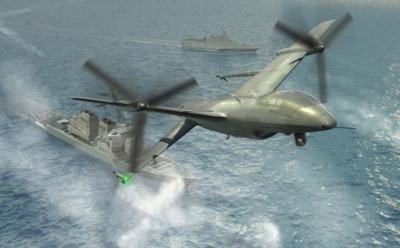Thu, Mar 26, 2015
System Would Enable Small Ships To Host Their Own Unmanned Air Systems
DARPA has awarded prime contracts for Phase 2 of Tern, a joint program between DARPA and the U.S. Navy’s Office of Naval Research (ONR). The goal of Tern is to give forward-deployed small ships the ability to serve as mobile launch and recovery sites for medium-altitude, long-endurance unmanned aerial systems (UAS).

These systems could provide long-range intelligence, surveillance and reconnaissance (ISR) and other capabilities over greater distances and time periods than is possible with current assets, including manned and unmanned helicopters. Further, a capacity to launch and retrieve aircraft on small ships would reduce the need for ground-based airstrips, which require significant dedicated infrastructure and resources. The two prime contractors selected by DARPA are AeroVironment, Inc., and Northrop Grumman Corp.
“To offer the equivalent of land-based UAS capabilities from small-deck ships, our Phase 2 performers are each designing a new unmanned air system intended to enable two previously unavailable capabilities: one, the ability for a UAS to take off and land from very confined spaces in elevated sea states and two, the ability for such a UAS to transition to efficient long-duration cruise missions,” said Dan Patt, DARPA program manager. “Tern’s goal is to develop breakthrough technologies that the Navy could realistically integrate into the future fleet and make it much easier, quicker and less expensive for the Defense Department to deploy persistent ISR and strike capabilities almost anywhere in the world.”
The first two phases of the Tern program focus on preliminary design and risk reduction. In Phase 3, one performer will be selected to build a full-scale demonstrator Tern system for initial ground-based testing. That testing would lead to a full-scale, at-sea demonstration of a prototype UAS on an at-sea platform with deck size similar to that of a destroyer or other surface combat vessel.
(DARPA artist's concept)
More News
Aero Linx: JAARS Nearly 1.5 billion people, using more than 5,500 languages, do not have a full Bible in their first language. Many of these people live in the most remote parts of>[...]
'Airplane Bounced Twice On The Grass Runway, Resulting In The Nose Wheel Separating From The Airplane...' Analysis: The pilot reported, “upon touchdown, the plane jumped back>[...]
"Burt is best known to the public for his historic designs of SpaceShipOne, Voyager, and GlobalFlyer, but for EAA members and aviation aficionados, his unique concepts began more t>[...]
"Polaris Dawn, the first of the program’s three human spaceflight missions, is targeted to launch to orbit no earlier than summer 2024. During the five-day mission, the crew >[...]
There Are SO Many Ways To Get YOUR Aero-News! It’s been a while since we have reminded everyone about all the ways we offer your daily dose of aviation news on-the-go...so he>[...]
 ANN's Daily Aero-Linx (05.04.24)
ANN's Daily Aero-Linx (05.04.24) NTSB Final Report: Quest Aircraft Co Inc Kodiak 100
NTSB Final Report: Quest Aircraft Co Inc Kodiak 100 Aero-News: Quote of the Day (05.04.24)
Aero-News: Quote of the Day (05.04.24) Aero-News: Quote of the Day (05.05.24)
Aero-News: Quote of the Day (05.05.24) Read/Watch/Listen... ANN Does It All
Read/Watch/Listen... ANN Does It All



